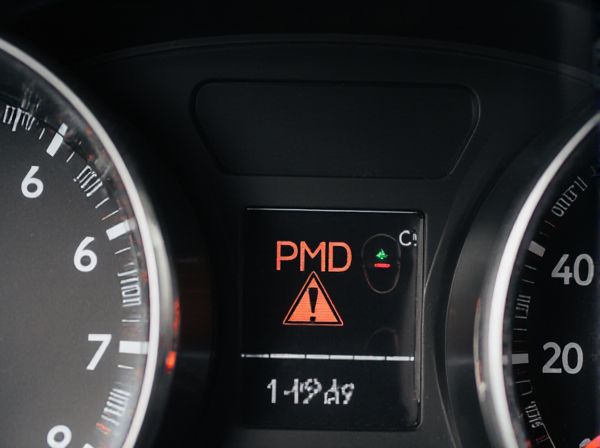
Photo illustration: Warning Light vs Indicator Light
Warning lights alert you to potential issues or urgent problems with your vehicle that require immediate attention to prevent damage or ensure safety. Indicator lights, on the other hand, provide information about your vehicle's operational status, such as turn signals or high beams, helping you communicate intentions to other drivers. Understanding the difference between warning and indicator lights ensures you respond appropriately to maintain your vehicle's performance and safety.
Table of Comparison
| Feature | Warning Light | Indicator Light |
|---|---|---|
| Purpose | Alerts driver to vehicle issues or malfunctions | Signals driver intention to turn or change lanes |
| Color | Typically red or amber for urgency | Usually green or blue |
| Examples | Engine warning, brake alert, oil pressure | Left/right turn signals, hazard lights |
| Action Required | Immediate attention or service needed | No immediate action; informs other drivers |
| Location on Dashboard | Grouped with critical alerts in central area | Positioned near speedometer or steering column |
Introduction to Warning Lights and Indicator Lights
Warning lights alert drivers to critical vehicle malfunctions requiring immediate attention, such as engine overheating or low oil pressure. Indicator lights provide information about operational statuses like turn signals or high beams, guiding safe and informed driving decisions. Both types of lights are essential components of a vehicle's dashboard, enhancing safety and functionality.
What Are Warning Lights?
Warning lights are dashboard signals designed to alert drivers to immediate issues or malfunctions within a vehicle, such as engine overheating, low oil pressure, or brake system problems. These lights are often red or amber and require prompt attention to prevent further damage or ensure safety. Unlike indicator lights that show general vehicle status or active functions, warning lights specifically indicate critical system failures or urgent maintenance needs.
What Are Indicator Lights?
Indicator lights are small, colored lights on a vehicle's dashboard that provide real-time information about system statuses such as turn signals, high beams, and cruise control. These lights help drivers understand the operational condition of vehicle functions without causing alarm. Unlike warning lights, indicator lights typically signal normal function or activation rather than a malfunction.
Key Differences Between Warning and Indicator Lights
Warning lights signal urgent issues requiring immediate attention, such as engine overheating or low oil pressure, designed to alert drivers to prevent damage or accidents. Indicator lights, on the other hand, provide status information about vehicle functions like turn signals, high beams, or cruise control activation, enhancing driver awareness without suggesting immediate action. Understanding the distinction helps drivers respond appropriately to vehicle alerts, ensuring safety and optimal performance.
Common Colors and Their Meanings
Warning lights commonly appear in red, signaling urgent issues like engine overheating or low oil pressure, requiring immediate attention to prevent damage. Indicator lights often use green or blue to convey normal operation states such as turn signals or high beam activation. Yellow or amber lights serve as cautionary indicators, alerting drivers to potential problems like low fuel or maintenance reminders without demanding immediate action.
Functions of Warning Lights in Vehicles
Warning lights in vehicles serve a critical function by alerting drivers to urgent issues that require immediate attention, such as engine overheating, low oil pressure, or brake system failures. These lights are typically illuminated in red or amber to indicate a potentially serious malfunction or safety concern that could compromise vehicle performance or safety if ignored. By promptly signaling these problems, warning lights help prevent further damage and ensure timely maintenance or emergency response.
Functions of Indicator Lights in Vehicles
Indicator lights in vehicles primarily function to signal the driver about the operational status of various systems, such as turn signals, high beams, and hazard lights. These lights provide real-time feedback to ensure safe driving by alerting the driver and surrounding road users to intended maneuvers. Indicator lights also help monitor essential functions like engine performance and door status, contributing to overall vehicle safety and efficiency.
Importance of Responding to Warning Lights
Warning lights signal critical vehicle issues such as engine overheating, low oil pressure, or brake failures requiring immediate attention to prevent severe damage or safety risks. Indicator lights, which show routine functions like turn signals or high beams, do not demand urgent action but provide essential information for safe driving practices. Prompt response to warning lights ensures vehicle reliability, driver safety, and minimizes costly repairs.
Misunderstandings Between Warning and Indicator Lights
Misunderstandings between warning lights and indicator lights often arise from their similar appearances on vehicle dashboards, yet they serve distinct purposes. Warning lights, such as the engine temperature or oil pressure lights, signal urgent issues requiring immediate attention to prevent damage, while indicator lights, like turn signals or high beam indicators, simply provide information about the vehicle's operational status. Confusing these lights can lead to neglecting critical problems or misinterpreting routine signals, impacting vehicle safety and maintenance.
Tips for Managing Dashboard Lights
Dashboard lights, including warning lights and indicator lights, provide essential information about your vehicle's status and safety. To effectively manage these lights, regularly consult the vehicle's owner manual to understand each symbol's meaning and prioritize urgent warning lights, such as engine or brake system alerts, over less critical indicator lights like turn signals or high beams. Routine vehicle maintenance, including oil changes and tire inspections, helps prevent warning lights from appearing and ensures safe driving conditions.
 caratoz.com
caratoz.com